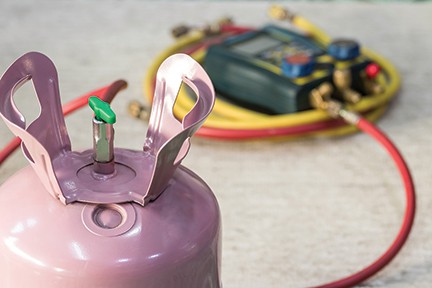Compiled by Facility Executive Staff
From the December 2021 Issue
With the developing world increasing its use of air conditioning in buildings and apparent warming temperature trends, the demand for cooling in all types of buildings is on an upward trajectory. Energy efficiency, carbon emissions, and related concerns all come into play here, and facilities professionals are a relevant stakeholder here. What solutions have been pursued to date? And, what might be on the horizon? This article shares insights from a 2016 report sponsored by the U.S. Department of Energy, Building Technologies Office. The report was prepared by Navigant Consulting (W.Goetzler, M.Guernsey, J.Young, and J.Fuhrman) and Oak Ridge National Laboratory (Omar Abdelaziz, PhD), and provided insight at that time that can serve as a basis for further progress. In 2022, Facility Executive will take a closer look at the strides made and what actions facility management teams might consider going forward.

More recently, in March 2020, a brief released by the U.S. Energy Information Administration (EIA) stated: In the Annual Energy Outlook 2020 (AEO2020) Reference case, the U.S. Energy Information Administration (EIA) projects that delivered energy for air conditioning will increase more than any other end use in residential and commercial buildings (also known as the buildings sector) through 2050, while energy consumption for space heating will decline. Higher residential and commercial energy consumption for air conditioning and lower energy consumption for space heating result from projected population shifts from colder to warmer parts of the United States, assumptions of warmer weather, and regional differences in sector growth.
The 2016 report mentioned above includes a number of insights, and we’ve summarized points here. For the full report, visit the U.S. Department of Energy website and search for “The Future of Air Conditioning for Buildings” report there.
Report From DOE Examines The Rise In Demand
From “The Future of Air Conditioning for Buildings” report: “Today, A/C equipment represents close to a $100 billion, 100 million-unit per year global market, and accounts for 4.5 exajoules (4.26 Quadrillion Btus) of site energy consumption per year, comprising just over 4% of global building site-energy consumption. While adoption of A/C in developed countries increased rapidly in the 20th century, the 21st century will see greater adoption in developing countries, especially those in hot and (possibly) humid climates with large and growing populations, such as India, China, Brazil, and Middle Eastern nations. The International Energy Agency (IEA) projects that A/C energy consumption by 2050 will increase 4.5 times over 2010 levels for non-Organization of Economic Coordination and Development (OECD) countries versus 1.3 times for OECD countries. Rising income and greater access to A/C equipment in many of these nations opens the door to building cooling for billions of people, which will provide significant benefits in increased human health and comfort.”
Global Warming Contributions
The rising temperature trends across the world has continued since the DOE report in 2016, and at that time, the authors stated: “Globally, stationary A/C systems account for nearly 700 million metric tons of direct and indirect CO2-equivalent emissions (MMTCO2e) annually. Indirect emissions from electricity generation account for approximately 74% of this total, with direct emissions of HFC and hydrochlorofluorocarbon (HCFC) refrigerants accounting for 7% and 19%, respectively. While electricity consumption is the largest driver of GHG emissions from A/C (i.e., indirect impacts), emissions of HCFC and HFC refrigerants have a disproportionately large global warming impact relative to their mass. Addressing direct emissions therefore offers an important path to substantially reducing A/C GHG emissions.
Transitioning to low-GWP refrigerants could eliminate the vast majority of direct emissions from A/C systems. With many available low-GWP alternative refrigerants having GWPs of 100 or less, industry has the opportunity to implement high-impact solutions for all applications. A theoretical 100% adoption of near-zero GWP refrigerants could reduce annual global A/C emissions by up to 26%, assuming no changes in efficiency. With preliminary testing indicating the potential for efficiency improvements for equipment using low-GWP refrigerants, reductions to indirect emissions are possible as well, especially if high-efficiency equipment adoption is incentivized globally through efficiency standards and labeling programs. Given the refrigerant options available today, DOE sees opportunity to reduce global A/C GHG emissions by 20% or more (75% or more of all direct emissions). Such a transition could occur in as short as a single turnover cycle of installed equipment, and would limit direct emissions growth, especially in markets that lack effective refrigerant management programs. In addition to a transition to low-GWP refrigerants, reducing emissions during initial charging, servicing, and end-of-life disposal could help further mitigate direct emissions. Deeper reductions in emissions are possible in the long-term from lower-GWP refrigerants and improved efficiency.”
Development Of Low-GWP A/C Systems
ASHRAE along with manufacturers and other relevant industry stakeholders have been researching and testing for effective, safe, and cost-effective low global warming potential (low-GWP) refrigerants. In “The Future of Air Conditioning for Buildings” report, the authors state: “The A/C industry has a long history of proactively engaging and helping to meet environmental goals through international cooperation and technology innovation. Manufacturers successfully developed products to transition away from ozone-depleting refrigerants and continually innovate to deliver lower cost products with higher efficiency and performance. Non-ozone-depleting HFCs and HFC blends (e.g., R-410A and R-134a) have replaced HCFC and CFC refrigerants and now dominate the industry in developed countries. However, the GWPs of today’s most common refrigerants are over a thousand times more powerful than the most prevalent GHG, carbon dioxide.

Products using low-GWP refrigerants and having comparable or improved efficiency relative to today’s typical equipment are already commercially available in four key equipment categories, including for ductless split systems, which are by far the largest market segment. For the remaining categories, energy-efficient products using low-GWP refrigerants are in varying stages of testing and development.
Many products that are currently available, or will become available in the near-term, provide GWP reductions of 50-75% or more compared to the most commonly used refrigerants. For example, manufacturers have debuted small, self-contained equipment using R-32, an HFC with a GWP of 677 that replaces R-410A (GWP=1,924), and chillers using R-1234ze, a hydrofluoroolefin (HFO) with a GWP of less than 1 that replaces R-134a (GWP=1,300). Standards organizations, government bodies, and other stakeholders are working together to expedite the revision of relevant safety standards and building codes to ensure the safe use of A/C systems using low-GWP refrigerants.”
At the time of the report’s publication, the low-GWP refrigerant research was underway. In 2022, Facility Executive will highlight the status of these research efforts.
The report stated at its time of publication: “Much of the R&D required before commercialization of some applications of alternative refrigerants, such as split and packaged central A/Cs, is already underway. Changing refrigerants requires system design changes before a product can be commercialized; even for refrigerants that industry deems as “drop-in” replacements, small refinements are needed, such as refrigerant-charge optimization and adjusting the size of the thermal expansion device. The level of engineering work required varies significantly by application and refrigerant choice. The R&D optimizes tradeoffs between GWP, performance, efficiency, flammability, and cost relative to current refrigerants.
To understand how different refrigerant alternatives affect the capacity and efficiency of common A/C equipment categories, the Air Conditioning, Heating, and Refrigeration Institute (AHRI) led an international group of manufacturers that conducted a series of tests known as the Low-GWP Alternative Refrigerants Evaluation Program (Low-GWP AREP). Oak Ridge National Laboratory (ORNL) conducted testing of several low-GWP refrigerants as part of Low-GWP AREP on a 5.25 kWth (1.5 ton) ductless mini-split A/C system designed for the most widely used refrigerant, R-410A. The results showed that with modest design optimization, most of these refrigerants provided similar or improved efficiency (-8% to +6%) and capacity (-16% to +13%) compared to R-410A in both moderate and high ambient temperature conditions. These results are encouraging because they suggest the potential for both direct and indirect GHG emissions reductions, as well as reduced operating costs due to higher efficiency. With full-system optimization for low-GWP refrigerants, further efficiency and capacity improvements over current systems are expected.
Keeping Buildings Cool
The future of air conditioning technologies and operations is currently in flux. As new research comes about and test sites share real-world results, facility executives will be front and center to upgrade, outfit, and improve their buildings to meet the demand.
Do you have a comment? Share your thoughts in the Comments section below, or send an e-mail to the Editor at acosgrove@groupc.com.
















![[VIDEO] Collect Asset Data at the Speed of Walking a Building](https://facilityexecutive.com/wp-content/uploads/2024/02/maxresdefault-324x160.jpg)